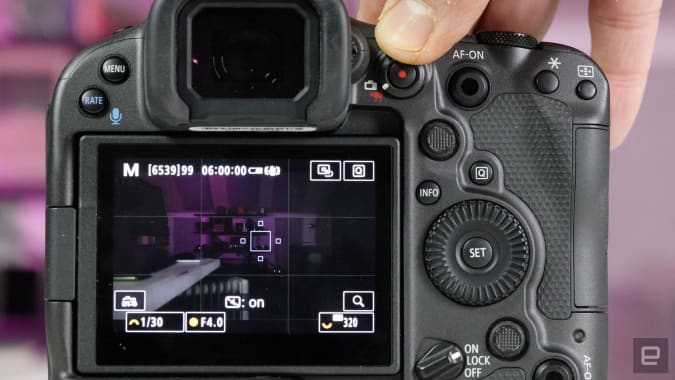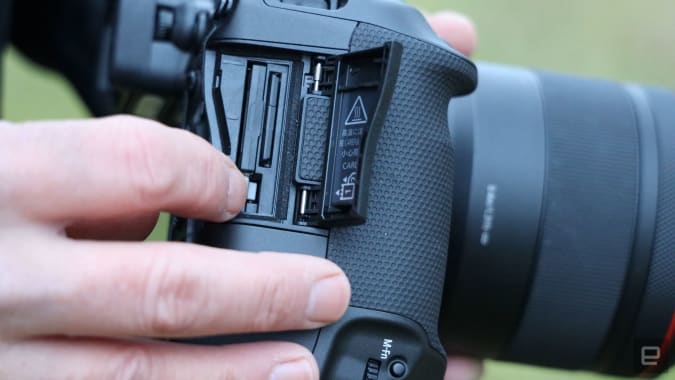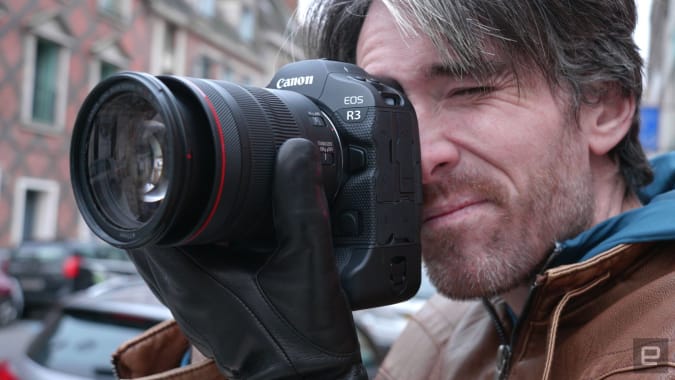After Sony released the A7 III way back in 2018, I wondered if Canon and Nikon could ever catch up to its autofocus and other technology. With the launch of the 24-megapixel EOS R3, however, it’s Canon that’s on the cutting edge with its “eye control” AF that lets you focus on a subject just by looking at it.
The R3 is also Canon’s first camera with a backside illuminated, stacked sensor. That gives it burst shooting speeds in silent mode of up to 30 fps with autofocus and auto-exposure enabled. Plus, it has top flight video specs with RAW capture at 6K up to 60 fps.
Pros
- Fast shooting speeds
- Reliable autofocus
- Good handling
- No-compromise video
- Innovative eye control AF
Cons
- High price
- Eye control AF limited
- Mediocre resolution
- Fiddly micro HDMI port
Here’s the rub, though: For $6,000 it has relatively low resolution, while Canon’s own 45-megapixel EOS R5 costs more than $2,000 less. So, who is this camera good for exactly? And is the eye control AF a useful feature, or just a toy? With some help from my pro photographer friends, I spent some time with a final production model to find out.
Body and handling
Gallery: Canon EOS R3 mirrorless camera review | 23 Photos
Gallery: Canon EOS R3 mirrorless camera review | 23 Photos
The first thing you’ll notice on the R3 is the big camera grip body that makes it look like a DSLR and mirrorless camera mashup. Much like the 1DX Mark III that inspired it, it has dual controls for both landscape and portrait shooting modes, including a matching shutter button, dials and joystick.
Despite the big body, the EOS R3 is relatively light at 2.3 pounds including a battery and memory card. The 1DX Mark III, by contrast, tips the scales at 3.17 pounds, while the EOS R5 is 1.6 pounds.
As you’d hope for a big camera, it has a big grip. That gives a feeling of security when you’re holding it, and it handles great even with big telephoto lenses like Canon’s RF 70-200mm f/2.8.
The R3 also packs plenty of dials and buttons so that you can operate the camera without diving into the menus, for the most part. The control layout is similar to the 1DX Mark III and uses the same infrared control button. That lets you set the focus point just by sliding your thumb over it – faster than a joystick, but easier to activate inadvertently until you get used to it.

Steve Dent/Engadget
A dedicated button lets you switch easily between photo and video modes, while giving you separate settings and menus for each mode. However, it uses the same old Canon menus, which aren’t quite as intuitive as on the latest models from Sony, Nikon and Panasonic. You can control it in a variety of ways, though, using the dials, joystick or touchscreen. That makes it quick to get to a setting, once you figure out where it is.
The big 3.2-inch touch display has a crisp 4.15-million dot resolution, nearly double that of the R5. For scrolling through menus, browsing photos and more, it’s extremely responsive – much more so than Sony’s A1 or any other camera I’ve tried for that matter. The display also flips out for low-angle shooting or vlogging, though the R3 is a bit heavy for the latter.
The 5.76-million dot OLED EVF is similarly sharp and offers a smooth 120 Hz refresh rate. It doesn’t stack up on paper to the 9.4-million dot, 240Hz EVF found on the A1, but I couldn’t see much difference between them, to be honest.
It uses the same huge LP-E19 battery from the 1DX Mark III that delivers up to 620 shots on a charge or about two and a quarter hours of 4K 30p video shooting. Depending on how you shoot, you may easily be able to exceed those figures, however.
For storage, you get one fast CFexpress type B and one SD UHS II slot. It’s nice to have the SD option if you prefer to shoot with those cards. However, if you want to back up the CFexpress card with SD, it’s going to slow performance. Since this is mostly a pro camera, Canon should have offered dual slots for both like Sony does, or perhaps two CFexpress slots.

Steve Dent/Engadget
It has a new hotshoe interface that supports Speedlite and other flashes along with accessories like Tascam’s new XLR 4-channel microphone interface. That finally matches what Sony and Panasonic have offered for years now.
The fiddly micro-HDMI port is not ideal for video shooters, and it’s an odd decision considering Canon had space with the R3’s big body. It also comes with USB-C for data transfers and in-camera charging, though you’ll need another optional accessory if you want to power the camera externally while you shoot.
Now, let’s talk about Canon’s new eye control feature. It’s only really useful if you calibrate it, but luckily that’s easy to do – you just stare at five dots. You might need to calibrate it multiple times depending on whether you’re wearing glasses and contacts, or even for different environments. Luckily, you can save up to six different settings.
Once it was calibrated, I could select an object to focus on just by looking at it. Even if the eye control circle wasn’t quite on a subject, the autofocus would usually select it if it was close. From there, the face, eye or subject tracking would kick in as needed to track the subject.
It worked even in tricky environments with lots of subjects or movement, though it turns off once you hit the focus button and start shooting. It worked fine for me, but didn’t function at all for my photographer friend with light blue eyes and an astigmatism. So if you’re interested in the feature, you may want to test it out before making a purchase, as the functionality seems to depend on your eye color and other factors.
Performance

Steve Dent/Engadget
First and foremost, the EOS R3 is a speed demon. That starts with the shutter, which goes all the way up to 1/64,000th of a second in electronic mode, faster than any other consumer camera. It also supports some of the fastest bursts we’ve seen, up to 30 fps in silent mode or 12 fps with the mechanical shutter. Unlike some recent Sony models, you get those full speeds with uncompressed and not just lossy RAW files.
You can take a lot of shots in those modes, too. At 30 fps with the electronic shutter, you can shoot 150 shots to an SD UHS II or CFexpress card before the buffer fills, according to Canon. However, I was able to shoot many more than that with a fast CFexpress card, with just a slight reduction in shooting speeds after the 150 frame mark. It’ll handle 1,000 RAW uncompressed photos or more with the mechanical shutter before stopping.
The Dual Pixel autofocus can keep up with those speeds too, so I had very few photos that weren’t sharp. Face and eye detection is fast and fluid for people, though a bit less reliable for animals or birds. The EOS R has a car tracking feature that’s mainly designed for race cars, and unfortunately I didn’t have access to a Bugatti Chiron during testing.
Shooting sports is this camera’s forte, and at an indoor soccer game with decent lighting, Samuel, the pro photographer I was working with, had only a few out-of-focus shots. It didn’t perform quite as well as the A1 did for birds, but it was still better than most cameras I’ve tried. Overall, the EOS R3 has a very powerful AF system that puts Canon right up there with Sony.
The IBIS system can deliver 8 stops of shake reduction with supported lenses, more than any rival camera. That allowed me to get sharp shots handheld at low shutter speeds when shooting in low light. And thanks to the sensor’s fast readout speeds, rolling shutter is well controlled and only noticeable on fast-moving subjects or quick pans.
Image Quality
Gallery: Canon EOS R3 camera sample images | 43 Photos
Gallery: Canon EOS R3 camera sample images | 43 Photos
The EOS R3 may be Canon’s best mirrorless camera yet for image quality, particularly when it comes to dynamic range. The new 24-megapixel sensor offers at least a stop more dynamic range than the EOS R5, giving you more room for adjustment with RAW images. JPEGs also look great straight out of the camera, with sharpness and noise reduction well balanced.
Canon’s color science is still the best out there, delivering stellar color accuracy and natural skin tones. As usual with Canon, it has a slight bias toward warm tones.
The R3 really shines in low light, too. Noise is nearly non-existent up to ISO 3200, with hardly any noticeable drop in dynamic range. It remains well controlled up to ISO 12,800, and images are usable at ISO 25,600 and even higher if you expose them perfectly.
The biggest downside is the lowish 24-megapixel resolution. With the 45-megapixel EOS R5 or 50-megapixel Sony A1, you can shoot birds or wildlife at a longer distance and still have room to crop in. The R3 is far more limited if you want to retain detail.
"control" - Google News
February 03, 2022 at 09:33PM
https://ift.tt/SjL49pBQG
Canon EOS R3 review: Innovative eye-control focus and speed, for a price - Engadget
"control" - Google News
https://ift.tt/j75bcrYny
https://ift.tt/xqbTOn1zH
Bagikan Berita Ini















0 Response to "Canon EOS R3 review: Innovative eye-control focus and speed, for a price - Engadget"
Post a Comment